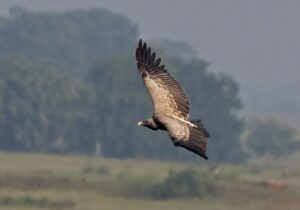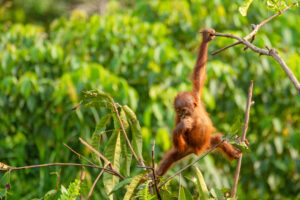Floating atop Antarctica’s Weddell Sea in 2018, a team of researchers from the Alfred Wegener Institute drilled through the Ekström Ice Shelf. What they found, 200 metres under the ice in total darkness and in water as cold as -2℃, surprised them.

The Alfred Wegner Institute (AWI) team drills at the site.
An exceptionally diverse network of living organisms thrived in that black watery underbelly up to nine kilometres away from the open ocean. In all, scientists counted 77 species in an “oasis” that might have supported life for the last 6,000 years.
The drillers took the samples from two cores. Live saber-shaped moss animals and unusual worms, called serpulids, highlighted the findings. The samples also included fossils.

Bryozoan and serpulid fossils.
What lies beneath
Serpulids are marine tubeworms with bodies that display feathery tentacles in bright red, pink, and orange. Around 300 species of the odd-looking worms inhabit a wide range of ocean habitats worldwide. To feed and protect themselves, they secrete a chalk-like substance, build tubes with it, and gather passing food particles with their tentacles.

A serpulid worm. Photo: John Turnbull
It’s highly uncommon to find serpulids under Antarctic ice. But life itself is not unheard of in harsh habitats. More typically, researchers find saber-shaped bryozoans (Greek for “moss animals”). The tubelike invertebrates grow in colonies that can survive for around 45 years.
Algae eaters somehow thrive far from water
The discovery stood out most for its distance from sunlight. Serpulids and bryozoans eat algae; algae photosynthesize. Despite enduring permanent darkness for thousands of years, the report says, life goes on far from the light-yielding shelf edges.
Perhaps more surprisingly, some even appeared to be thriving. The annual growth among four of the 77 species compared favorably to similar animals in open marine Antarctic habitats.

An ice shelf is a thick platform of mixed glacier ice and sea ice that forms where the glacier meets the coastline. Photo: Shutterstock
Dr. David Barnes is the study’s lead author and a marine biologist at the British Antarctic Survey. “This discovery of so much life living in these extreme conditions is a complete surprise,” he said. “[It] reminds us how Antarctic marine life is so unique and special. It’s amazing that we found evidence of so many animal types. [M]ost feed on microalgae (phytoplankton), yet no plants or algae can live in this environment.”
How do the animals in the Ekström Ice Shelf feed themselves? The team concluded that enough algae must drift in from beyond the shelf to support the creatures living inside. It’s a bit hard to imagine algae particles retaining enough nutritional value to sustain life over nine kilometres in lightless seawater.
It might be even harder to process that it’s apparently been happening since around 4,000 BC. Dr. Gerhard Kuhn coordinated the drilling project and co-authored the study. He called the habitat’s six-millennium age “another surprise.”
“Carbon dating of dead fragments of these seafloor animals varied from current to 5,800 years [ago],” he said. “So, despite living 3-9km from the nearest open water, an oasis of life may have existed continuously for nearly 6,000 years.”
Marginal ice shelf habitats at risk
Cameras have captured life in the dark, frigid habitats, but samples are rare. As Antarctic ice continues to disappear, communities like those of the serpulids and bryozoans face depletion.
Current theories regarding life under ice shelves suggest that all life grows less abundant as you move farther away from open water and sunlight. Past studies have revealed some mobile scavenger inhabitants, such as fish, krill, and jellies. Immobile filter feeders are the next step down the food chain.
As the ice recedes, so do opportunities to study the habitats it supports at the limits of survival.






